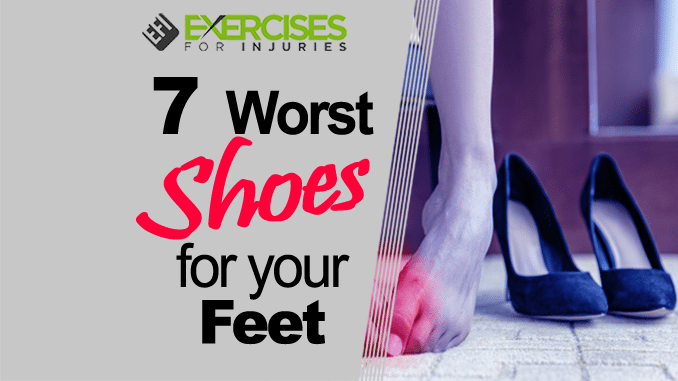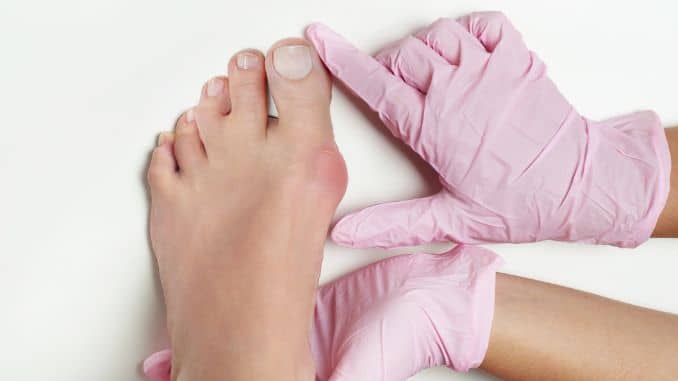
You may not think about it much, but what you wear on your feet can have a big impact on your health. For instance, if your shoes put excess strain on your feet or knees, it might increase your chances of developing arthritis. So, what shoes should you avoid wearing? Let’s find out by looking at the seven worst shoes for your feet. Plus, we’ll suggest some comfortable alternatives to these unhealthy footwear options.
Basic Geometry
When an architect designs a house or building, one of the main factors to consider is the structural strength. The support system must be exact or else the building might collapse during a strong wind. They even design buildings to withstand earthquakes by considering geometric forces.
Your body is designed similarly. Your spine, hips, knees, ankles and feet all have a specific geometric relationship to each other. If the natural way you are meant to walk and stand is disrupted, problems can appear, such as with the following types of shoes.
1. High Heels
We start with this class of footwear since it can produce many health problems. Also, other shoe styles may cause similar problems that we will refer back to.
Up to 72 percent of women wear high heels at some time in their life. They might be used for special occasions or a night out. Some even wear high heels every day at work. You may like to feel taller or just like the look, but high heels put an unnatural strain on various parts of your body. For starters, your ankles are flexed constantly, which puts stress on the joint in a way that goes beyond its design.
When you wear high heels, you also have to focus more on balance. This means that you begin to use other parts of your body not involved in normal standing or walking. This can put stress on your spinal column — perhaps even up to your neck. Heels cause you to lean forward and to compensate, the normal curvature of your spine must change or else you’ll fall on your face.
The change in posture also moves your back and hips out of their normal alignment as well as putting excessive pressure on your knees. Finally, the balls of your feet must sustain much more weight than normal.
Long-term damage from high heels
If you wear high heels long enough, it can actually lead to permanent or semipermanent anatomical changes. Here are some chronic problems that can appear due to overuse of high heels:
- Pump bump is a bump that forms on the back of their heel or Achilles tendon; can result in swelling, bursitis or even permanent deformity
- The gastrocnemius (calf) muscle can end up being shorter than normal since you are always on your toes
- Any joint (hip, knee, ankle or feet) can become damaged if stressed for too long, such as by balancing on high heels; chronic pain and even osteoarthritis are possible results
- Stress fractures can occur in the bones of the feet due to excess pressure
- Vertebrae slippage, which is caused by stress on your spin, is possible and, in the worst case, foraminal stenosis can occur; this means your spinal canal is narrowed and can lead to symptoms related to a pinched nerve
Foraminal stenosis may cause symptoms like:
- Tingling or numbness
- Muscle spasm
- Cramps
- Pain, which can radiate to the buttocks or down the leg
One final severe injury that can be caused by high heels, even if you only wear them once, is an ankle sprain or fracture. If you misstep while wearing high heels, you have a much higher chance of causing serious damage to your ankle joint.
2. Narrow or Pointed Toe Shoes
Some people like the fashion statement that goes along with pointed toe shoes, but your feet certainly are not fans. By squeezing all your toes into a small space, the bony alignment gets distorted. In the long term, abnormal big toe bone growth can occur, leading to a condition called a bunion (or hallux valgus). Nerve damage, blisters and hammertoes also can be caused by wearing pointed toe shoes. This is one shoe fashion that men may also have trouble with.
3. Flat Shoes
These could be ballet-style shoes or other similar types of slip-on shoes. Since flat shoes have no arch support, this could put a strain on the back, hips, knees and ankles. Other common problems with wearing archless shoes for long periods are fallen arches and plantar fasciitis.
Fallen arches can cause symptoms like:
- Feet get tired quickly
- Foot pain, ache or burning
- Swelling of the bottom of your feet
- Restricted foot movement
- Ankle, knee or back pain
Plantar fasciitis is caused by the inflammation of the fibers that run along the bottom of your foot. This condition may be caused by wearing flat shoes or by being on your feet for long periods of time. The classic symptom of plantar fasciitis is the pain in the heel area when walking, especially when you get up in the morning or after sitting for awhile then walking.
4. Flip-flops
During the summer, it feels great to let your feet breathe, but flip-flops can expose your feet to injury. If you have problems with diabetes or neuropathy, it’s important to keep your feet protected, so it’s probably best to not use open-toed sandals or flip-flops. Plus, like other flat footwear, flip-flops provide no arch support.
5. Platform Shoes
Depending on the design, these shoes may combine the danger of various shoe types. For instance, platforms are often set up like high heels. In other cases, they might have minimal arch support. Also, the risk for ankle injury might be at its peak with platform shoes. If you twist your ankle wearing these, you have a greater distance between your feet and the floor. This means your ankle gets leveraged out of place more severely if you twist your ankle while wearing platforms. The extra distance can increase the risk of an ankle fracture.
6. Any Shoe That is Too Small
Up to 90 percent of women wear shoes that are too small for them. This leads to the bones of the toes constantly rubbing against each other and the shoe lining. The results in the short term are blisters, calluses and corns. In the long term, tight-fitting shoes can lead to bone deformities like bunions, hammertoes and arthritis. These conditions are very hard to treat and may even require surgery.
7. Hiking Boots, Running Shoes and Walking Shoes
You might be thinking that these types of footwear are designed for good support and that’s usually correct. However, many people make the mistake of going for a long hike or run with a brand-new pair of boots or shoes. When new, footwear is often stiff and not yet adjusted to the shape of your feet. This can lead to severe blistering. Modern running gear may not require a break-in period but boots usually do.
Smart Footwear Solutions
When choosing footwear, consider these guidelines inorder to avoid problems:
- Always wear the correct size shoe as too small only hurts your feet
- If you must wear heels, keep them to less than 2 inches; shoes without elevated heels are best
- If you use heels, find ones with a larger surface area instead of stilettos as this allows you to be more steady on your feet
- Make sure the area where your toes fit has enough room; if the shoe feels tight at all, it’s probably too narrow
- If you wear flip-flops, try ones that have a more substantial sole that includes arch support
- Use arch inserts in flat shoes; if you have fallen arches or plantar fasciitis, you may even need custom orthotics made by a podiatrist
- Try performance pumps as these have wider reinforced heels and athletic shoe construction; this style gives more room and better support
- Take the time to break in your footwear before going on a long hike or running a 10K
Are you suffering from plantar fasciitis pain? Make sure to check out the Plantar Fasciitis Relief in 7 Days program, here!



